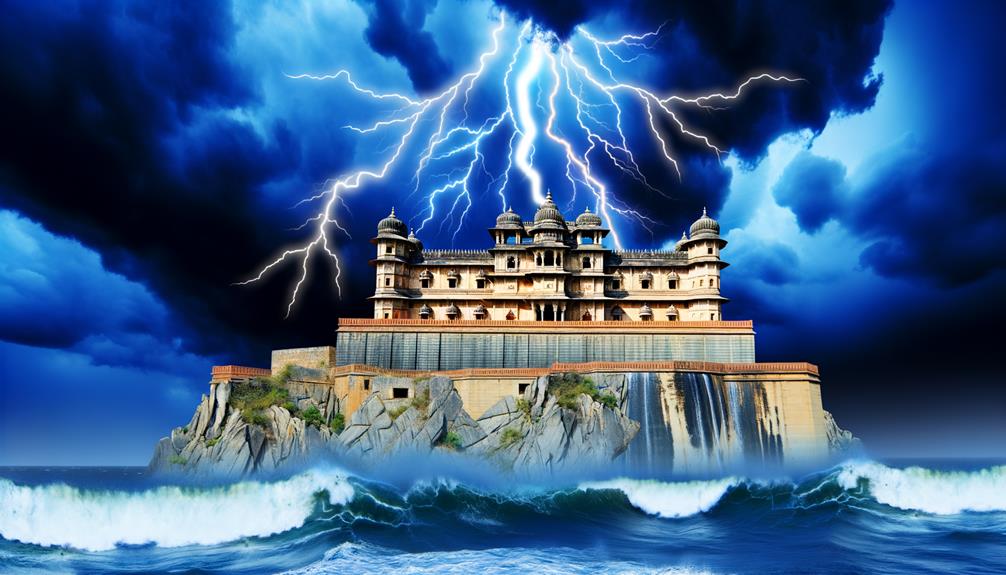Some may dismiss Indra's rule over storms as outdated folklore with no bearing on our present-day existence.
However, I'd like to present a contrasting view. As we delve into the depth of Indra's authority, we discover it's not just a reflection of nature's raw, elemental strength. It's also a vibrant narrative spun from the threads of age-old wisdom and cultural importance.
Let's unpack the intricate facets of this intriguing deity's sphere of influence, showing how it goes way beyond simple command over thunder and lightning. This exploration will inevitably lead us to a more profound understanding of the intricacies of Hindu mythology and its role in shaping our perception of the natural environment.
So, are we ready to start this journey?
Understanding Indra's Mythical Origins

Digging into the mystical beginnings of Indra, it becomes obvious that the ancient and somewhat ambiguous roots are deeply embedded in the study of word origins and symbols. These range from 'ind-u' meaning a raindrop, to 'ind' denoting immense power, or 'ina' indicating strength.
As the deity Indra, he presides as the ruler of all gods, personifying the fury of storm gods from different myths. As described in Vedic mythology and the Rig Veda, his sphere of control includes thunder and rain, the heavens, and war.
Indra is revered as the god of thunder. His symbolic connection with thunder and rain is clearly shown in his preferred weapon, the Vajra, a thunderbolt he commands with unmatched power. The legend of Indra is filled with stories of him clashing with demons, safeguarding humanity, and causing rainfall and prosperity. His character is a beacon of bravery and leadership, reflecting the pure, unbound power of nature's elements.
Indra's significance goes beyond the realm of myths, influencing art, literature, and cultural customs. This demonstrates the persistent impact of this god, who symbolizes strength, courage, and inherent authority.
The Iconography of Indra
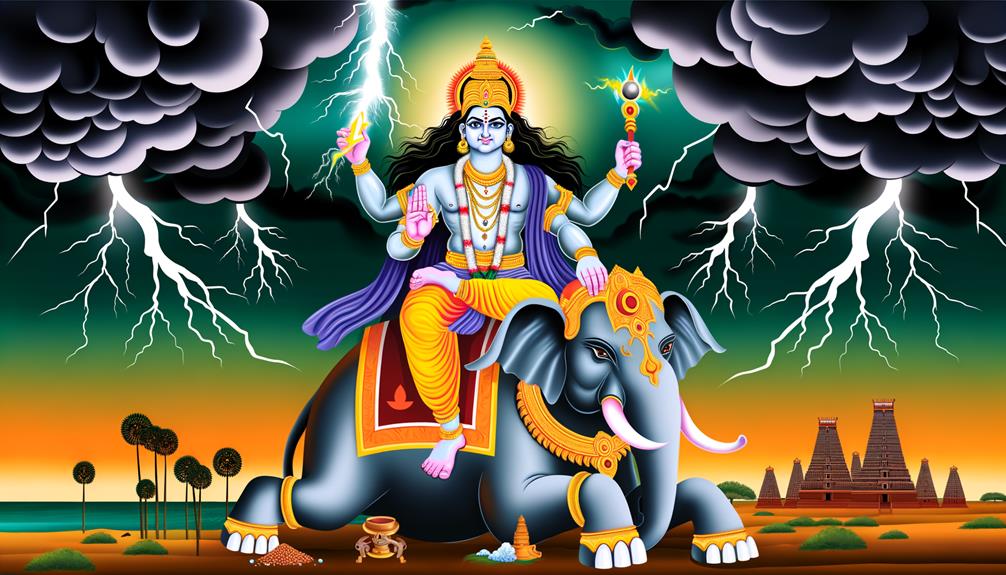
Let's take a closer look at the iconography of Indra, which is brimming with symbolic richness and cultural relevance. Often, you'll see him holding the Vajra, a mighty lightning thunderbolt weapon. This divine tool amplifies Indra's identity as the divinity of thunder and rain, and the one who governs the skies.
Did you know that the number 46 holds a special connection to Indra in certain mythologies? It's a nod to his status as the king of gods, ruling over the 46 sections of heaven. He's frequently portrayed seated on a white elephant named Airavata, a symbol of royal majesty and strength. His dwelling, a radiant city on Mount Meru, further strengthens his image as a divine monarch.
Interestingly, while Indra's warrior persona is often highlighted, his depictions with his partner, Indrani, during significant events in a Jain Tirthankara's life, present a gentler, kinder side. This dual perspective showcases the intricate role Indra plays in different mythologies.
Even though Buddhism and Jainism interpret Indra differently, they both recognize his impact. The multifaceted portrayals of this deity broaden our comprehension, helping us grasp the depth of Indra's iconography and understand its cultural bearings. This deeper understanding can bring us closer to appreciating the nuances of this complex deity.
Indra's Role in Vedic Texts
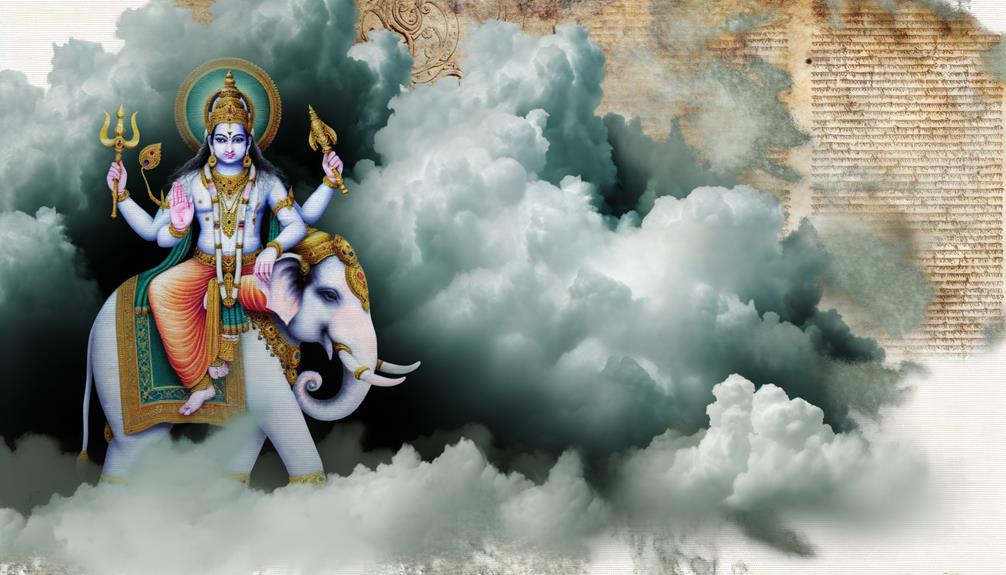
In the extensive collection of Vedic texts, the role of Indra is both varied and important. He's not just a deity of weather elements like lightning and thunderstorms, but also a respected fighter and a representation of order. Indra, as the leader of the gods, is often shown in his chariot, symbolizing his authority and might. He is frequently depicted in combat with the demon Vritra, an important act that emphasizes his role as a guardian and a bringer of order.
Let's briefly review the key aspects of Indra:
| Aspect | Description |
|---|---|
| Depictions | Indra is commonly shown holding a thunderbolt, a sign of his power over rain and thunderstorms. |
| Portrayals | Often shown as a fighter, Indra's conflicts with demons like Vritra highlight his role as a defender. |
| Significance | As the leader of the gods, Indra has a prominent position among the collection of gods and goddesses in the Vedic texts. |
Indra's role in Vedic texts is not fixed, which reflects the intricate nature of this key deity. His fights, his control over the elements, and his leadership all contribute to a character that continues to intrigue readers to this day.
Indra's Influence on Other Religions
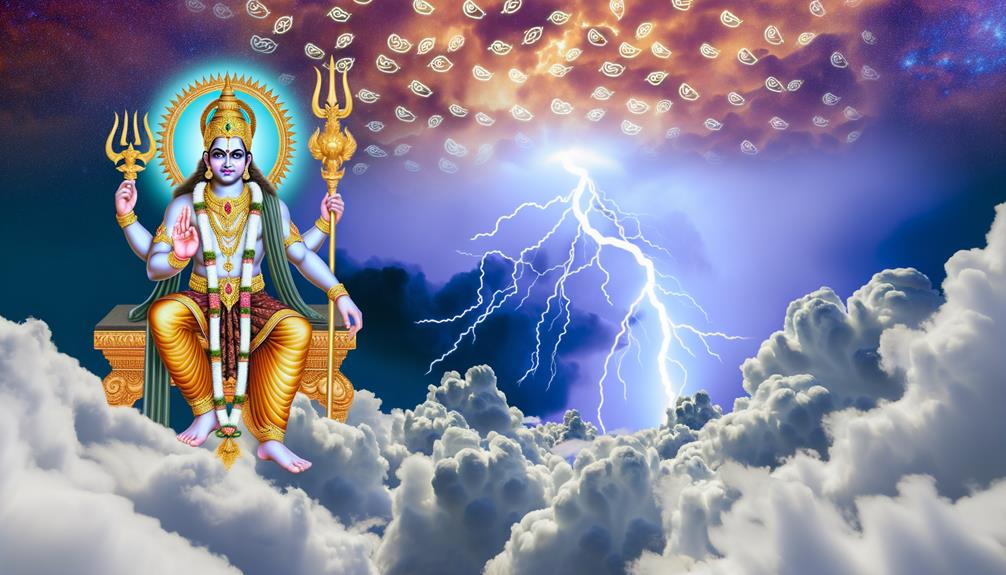
Indra holds a pivotal role, not merely in Vedic texts, but also in quite a few other faiths, including Hinduism, Buddhism, and Jainism. His presence in these religions is diverse and vital. Within the framework of Hindu belief systems, Indra is highly esteemed. He's the king of gods, revered as a defender and a leader among celestial beings.
But his impact isn't confined to the borders of India. In Buddhist belief systems, where he's known as Sakra, Indra is a protective deity who's adored by many. Even the ancient Greeks have a version of Indra, drawing a comparison between him and their own deity, Zeus.
Let's quickly look into the kind of influence Indra has had:
- Hinduism
- Regarded as the king of gods
- Admired as a defender
- Buddhism
- Recognized as Sakra
- Seen as a protective deity
- Other Beliefs and Cultures
- Resembles Zeus in ancient Greek lore
- Known as Pah En in Chinese tradition.
Artistic Representations of Indra
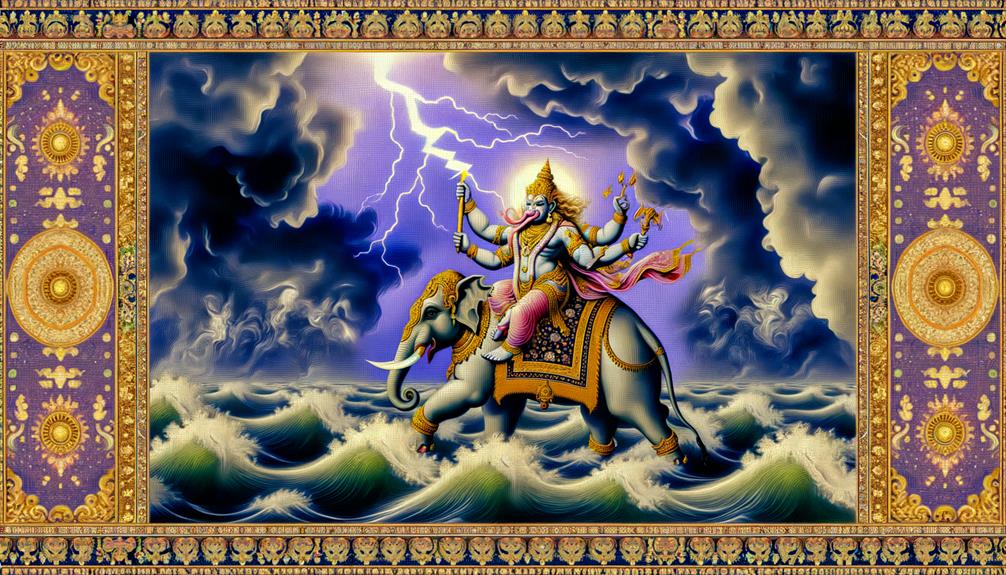
Let's talk about the artistic interpretations of Indra, shall we? They're quite the sight! You'll often see him holding a thunderbolt weapon, the Vajra, while sitting on a white elephant named Airavata. These images capture his intricate personality and his all-encompassing power. As a deity in Hinduism, he's portrayed fighting the serpent Vritra, which signifies his duty in upholding the cosmic order.
Let's break down these representations in a straightforward manner:
| Symbol | Meaning |
|---|---|
| Vajra | A thunderbolt weapon, stands for his omnipotence |
| White Elephant (Airavata) | Indra's vehicle, which represents royalty and power |
| Battle with Serpent Vritra | Represents his duty in maintaining cosmic order |
Moving to the art from the BCE era, Indra is often shown in divine regions, frequently on Mount Sumeru. This placement emphasizes his status as a divine being. The artistic depictions of him, sitting on his white elephant, holding the Vajra, crowned with royal headgear, paint a detailed image of a powerful, multifaceted personality. If we shift our focus to Buddhism, you'll find him portrayed as a protector and advocate of the faith. This representation further adds to his layered character across various cultures and religions. By examining these artistic interpretations, we get a clearer picture of Indra's role and relevance in these ancient belief systems.
Frequently Asked Questions
Why No One Worship Indra?
You might wonder why Indra isn't worshipped as much these days. Well, it seems that Indra's importance has waned in the literature that came after the Vedas. Also, as cultural beliefs evolved, people shifted their attention to other gods. Not to mention, societal values changed too, which played a part in this lessened reverence.
What Is the Significance of Indra?
Indra, who's known as the god of weather, has a significant role as the one who keeps everything in balance. He's quite a figure in Hinduism, but over time, especially after the Vedic period, he's become somewhat less significant, even though he still has a role in many mythological stories.
Is Indra the God of Storms?
Absolutely, I am indeed the deity associated with storms. Thunder, lightning, and rain fall under my control, and you'll often see me depicted with a thunderbolt in hand. This power over the weather plays a vital role in Hindu beliefs, especially concerning farming and agriculture.
Why Did Indra Seduce Ahalya?
Indra's attempt to seduce Ahalya was far from easy. Motivated by intense desire, he fooled her, causing severe fallouts. This story from Hindu mythology serves as a warning, underlining the severe fallout from treachery.
Conclusion
The puzzle of Indra's storm-filled authority continues to baffle us. This is a sphere where thunder, lightning, and the essential rain are controlled. His symbols and roles are plentiful and diverse, suggesting an intricate depth in mythology that's not easy to fully comprehend.
As I pore over his various artistic depictions, it becomes apparent that understanding Indra is akin to delving into the very core of Hindu mythology. What a fascinating adventure it's shaping up to be!

